

DRC: UNLIKE ANY OTHER PLACE ON EARTH
The Democratic Republic of the Congo (DRC) is about the size of western Europe and home to the world’s second largest rainforest, famous for its great apes, forest elephants, and other large mammals you won’t find in the Amazon. The DRC is also home to over 200 distinct ethnic groups that speak 242 languages, making it the world’s third most diverse nation.
And yet, while the DRC is rich with culture and biodiversity, it remains one of the world’s least developed nations. Plagued by systemic corruption and decades of conflict, almost two-third’s of the DRC’s 93 million people live under the poverty line.
MALARIA IN THE DRC: TROUBLING TRENDS
Malaria is endemic throughout the country. Around 60% of all hospital visits in the DRC are attributed to malaria. With an estimated 30.3 million malaria cases and 77,000 malaria deaths in 2021, the DRC carries approximately 12% of the global malaria burden.
Here’s what’s particularly troubling: after making significant progress in the early 2000’s, since 2015 the DRC has seen annual malaria cases increase steadily by 30%. So why has progress stalled in Central Africa’s largest and most populous country?
DRC’S DISPLACEMENT CRISIS
In recent years, surging intercommunal violence and military offensives – particularly in eastern DRC – have triggered vast and repeated displacement of Congolese people. In 2021, there were 5.4 million internally displaced people (IDPs) in the DRC, compared to 1.5 million in 2015.
Displaced families are particularly vulnerable to malaria. Many must live in tents or in crowded homes that offer little to no mosquito protection. Poor sanitary conditions within refugee and IDP camps create ideal breeding grounds for mosquitoes and other vectors.
EMERGING INSECTICIDE RESISTANCE
In addition to rising insecurity and displacement, emerging insecticide resistance poses a major threat to malaria control efforts in the DRC. According to UNICEF, entomological monitoring across the DRC revealed widespread mosquito resistance to pyrethroids, the insecticide commonly used for bed nets. This means that millions of pyrethroid-based bed nets currently being used in the DRC are no longer providing optimal protection against malaria.
HOW WE’RE TAKING ACTION
United to Beat Malaria is funding the distribution of 67,814 insecticide-treated bed nets, which will protect an estimated 122,000 people from malaria living in Eastern DRC’s conflict-affected Tanganyika province.
This 2-year project will distribute two types of innovative bed nets – pyrethroid and piperonyl butoxide (PBO) nets and dual-active ingredient nets – that are highly effective against all malaria-carrying mosquitoes, including those resistant to pyrethroids.
Our on-the-ground partner, UNICEF, will work with community-based organizations to carry out the bed-net distributions within five Tanganyika communities. This campaign will also include malaria education and follow-up home visits to ensure proper use of the bed nets, along with promotion on local radio and community events.
This project will prioritize those most vulnerable – specifically, young children, pregnant women, and displaced families.
Click here to learn more about past projects we’ve supported in the DRC.